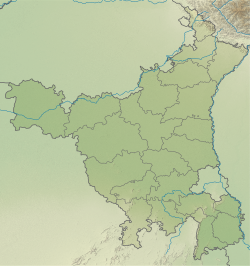| Thanesar Pathar Mosque | |
|---|---|
 Partial ruins of the mosque, in 2008 | |
| Religion | |
| Affiliation | Islam (former) |
| Ecclesiastical or organizational status |
|
| Status | Abandoned (partial ruinous state) |
| Location | |
| Location | Thanesar, Haryana |
Location of the former mosque in Haryana | |
| Geographic coordinates | 29°58′33″N76°49′32″E / 29.9759144°N 76.8255395°E |
| Architecture | |
| Type | Mosque architecture |
| Style | Mughal architecture |
| Completed | 17th century |
| Specifications | |
| Minaret(s) | Two (maybe more) (Now in partial ruins) |
| Materials | Red sandstone |
| Official name | Thanesar Pathar Mosque |
| Reference no. | N-HR-57 |
The Thanesar Pathar Mosque, also known as the Pathar Masjid, is a former mosque and now historical monument, located in Thanesar, in the state of Haryana, India. Believed to be built in 17th century, the mosque is located in the Kurukshetra district and is a Monument of National Importance. [1] [2]
